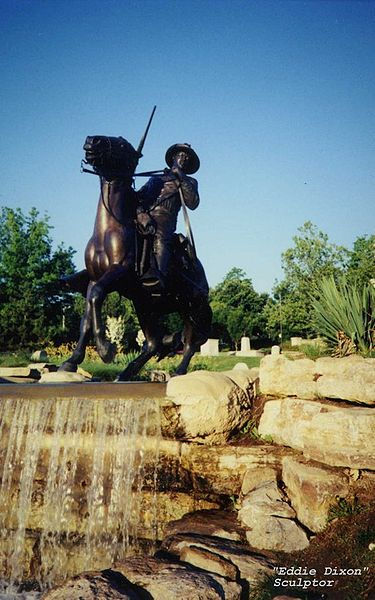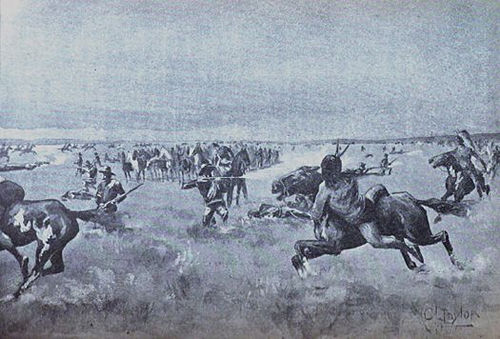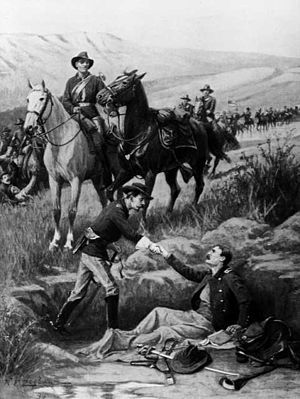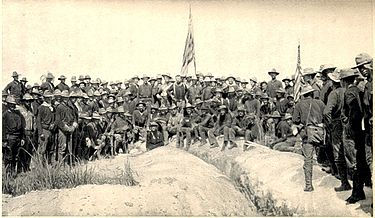|
Books by
Jeffery Robenalt
|
|
| At
the close of the Civil War, the United States Congress authorized
the formation of six regiments of African American soldiers; two regiments
of cavalry and four regiments of infantry. In 1869, Congress agreed
on a general troop reduction and the number of black infantry units
was reduced to two. African American men were given the opportunity
to enlist in the Ninth and Tenth Cavalry Regiments or the Twenty-fourth
and Twenty-fifth Infantry Regiments. During the latter half of the
nineteenth century, the four black regiments represented nearly ten
percent of the entire United States army’s effective fighting force.
Blacks were even more numerous in the West. In many western commands,
blacks made up more than fifty percent of the available troops. Although
the contributions of the African American regiments were significant
in taming the West, their accomplishments have always been tempered
by the color of their skin. |
10th Cavalry
in Cuba
Wikimedia
Commons |
25th Infantry
Regiment
Wikimedia
Commons |
Buffalo Soldier
was the name given by the Plains Indians to African American soldiers,
both cavalry and infantry, who served on the western frontier. Some
say the nickname was derived from the tightly curled hair of the black
soldiers that resembled the curly hair on the face of a Bison. Others
said that the name was given in honor of the tenacity, bravery, and
strength of the buffalo that the black soldiers displayed in a fight.
One thing is certain, since the Indians revered the buffalo, the nickname
was one of respect, and the Buffalo Soldiers proudly featured a bison
on their regimental crest. Predecessors to the Buffalo Soldiers first
served in Indian Territory during the Civil War. In 1863, they contributed
greatly to Union victories at Cabin Creek and Honey Springs and in
a second engagement at Cabin Creek in 1864. Of course, the blacks
were motivated by the fact that Confederates threatened to return
captured African-Americans to slavery or to take no prisoners.
The Ninth Cavalry Regiment was organized in New Orleans on September
21, 1866. The unit’s first commanding officer was Colonel Edward Hatch.
Hatch, like all other officers in the African-American regiments,
was white. The term of enlistment in the regiment was five years and
the pay was $13 a month plus room, board, and clothing. “We Can, We
Will” was the Ninth Regiment’s motto, and it remains so today. Most
of the unit’s soldiers were recruited from the vicinity of New Orleans
or from Kentucky, while the horses were purchased in St. Louis. Empty
New Orleans cotton presses were first used as barracks, but a cholera
epidemic caused the crowded camp to be moved to Carrollton. The Ninth
Cavalry was nearly at full strength by the end of March 1867, with
885 enlisted men, or an average of more than seventy men per troop.
The unit was ordered to San
Antonio in April for three months of training, but L and M Troops
were sent directly to their permanent duty station at Brownsville,
Texas.
The Tenth Cavalry Regiment was mustered into service in 1866 at Fort
Leavenworth, Kansas. By the end of July 1867, eight companies had
been recruited from the Departments of Arkansas, Missouri, and the
Platte. Unfortunately, the commander at Fort Leavenworth was openly
opposed to African-Americans serving in the regular army, and he made
life as difficult as possible for the new troops. The Tenth’s commanding
officer, Colonel Benjamin Grierson, finally requested a transfer.
In answer to the request, the regiment was transferred to Fort Riley,
Kansas in August, and three of its companies were moved to Indian
Territory, in what would later become Oklahoma, to protect the tribes
and maintain the peace. In early 1869, the remainder of the Tenth
was sent to Indian Territory, where they remained until the end of
the Red River War in 1875. “Ready and Forward,” was the motto of the
Tenth Cavalry when it was formed and remains so today.” |
 |
Buffalo Soldiers
Monument at Fort Leavenworth, Kansas
Wikimedia
Commons |
The Twenty-Fourth
Infantry Regiment was mustered into service on November 1, 1869. Most
of the men were drawn from the proposed Thirty-Eighth and Forty-First
(Colored) Infantry Regiments, when the United States Congress called
for the formation of two African-American infantry regiments instead
of the four contained in the original legislation. Recruits were also
drawn from freedmen or from the ranks of other colored units in the
army, but all of the enlisted soldiers were black. From the day the
Twenty-Fourth was activated, until the dawn of the Spanish-American
War in 1898, the unit served throughout the western United States.
Its missions were diverse and varied, including serving as the garrison
for many frontier posts, fighting Indians, apprehending outlaws, and
guarding the border along the Rio Grande. “Semper Paratus or “Always
Prepared” was the unit’s motto. The Twenty-Fourth Infantry Regiment
is noted for its checkered past, with mostly meritorious garrison
service and valorous combat service, marred by a few serious transgressions
such as the Houston, Texas
riot of 1917.
Like the Twenty-Fourth Infantry Regiment, the Twenty-Fifth was consolidated
from the proposed Thirty-Ninth and Fortieth Infantry Regiments in
March of 1869, when the original legislation was amended. In April,
the newly constituted Twenty-Fifth Regiment established its first
regimental headquarters at Jackson Barracks, Louisiana. The unit was
commanded by Colonel Joseph A. Mower. The regiment was transferred
to San Antonio, Texas
for a brief period in May 1870, but its companies were soon ordered
to a number of small frontier Texas posts, including Fort Bliss, Fort
Davis, Fort Stockton, and Fort Clark. For the next ten years, the
Twenty-Fifth served along the Mexican border in both Texas and New
Mexico. The unit was responsible for providing border security, constructing
roads and telegraph lines, and conducting occasional operations against
the Indians. In 1880, the Twenty-Fifth was transferred to the northern
Great Plains, with operations mostly in Dakota Territory.
Near
the end of August 1867, the Buffalo Soldiers of the Tenth Cavalry
had one of their first fights at the Saline River some twenty-five
miles northwest of Fort Hays, Kansas. After a railroad work party
was wiped out, Company F of the Tenth was ordered to locate the band
of hostile Cheyenne who had perpetrated the massacre. While following
an active trail, Company F, commanded by Captain George Ames, was
surrounded by 400 Cheyenne warriors. Captain Ames immediately ordered
the company to form a hollow square formation with the horses in the
middle. He then slowly walked his command to better ground while maintaining
the defensive square. After eight hours of fighting, 2000 rounds fired,
and nearly fifteen miles of movement, the Cheyenne finally withdrew.
Only one Company F trooper was killed, and Captain Ames, who had been
wounded in the hip, later commented, “It is the greatest wonder in
the world that my command escaped being massacred.” Ames also stated
that his men displayed “…devotion to duty and coolness under fire.”
|
 |
Wounded and
Lifted on a Horse
Painting by C. Taylor describes when Captain Armes was wounded
Wikimedia
Commons |
| In September
and October of 1868, Troops H and I of the Tenth Cavalry Regiment,
commanded by Brevet Lieutenant Colonel (Captain in the Regular Army)
Louis H. Carpenter, took part in two notable actions. The initial
action was the Buffalo Soldiers’ rescue of Lieutenant Colonel Forsyth
and a party of 48 white scouts, who had been surrounded and attacked
by some 700 warriors of mixed tribes on a small sand island on the
north fork of the Republican River. The fight became known as the
Battle of Beecher Island. The second episode occurred two weeks after
Carpenter had returned to Fort Wallace with the Beecher Island survivors.
Troops H and I were ordered to escort supply wagons to the Fifth Cavalry
near Beaver Creek. As they neared the creek, the Buffalo Soldiers
were attacked by a large force of Indians. After a hot running fight
and an effective defensive stand, the “hostiles” retreated. Lieutenant
Colonel Carpenter was later awarded the Medal of Honor for the two
separate actions. |
 |
The Rescue depicts
Bvt Col. Louis H. Carpenter greeting Lt. Col. G. A. Forsyth at the
Battle of Beecher Island
Wikimedia
Commons |
In July 1867,
elements of the Ninth Cavalry Regiment were transferred to western
and southwestern Texas and detailed to maintain law and order from
Fort Clark to El
Paso, the vast area that stretched between the Rio Grande and
the Concho Rivers. Troops A, B, E, and K, under the command of Colonel
Hatch, and the Regimental Headquarters were posted to Fort
Stockton, and Troops C, D, F, G, H, and I, under the command of
Lieutenant Colonel Wesley Merritt were stationed at Fort
Davis. Troops L and M, under the command of Lieutenant Hamilton,
had previously been dispatched to Brownsville
for garrison duty. The Ninth remained in Texas for eight years, nearly
all of it in the field, where they participated in the Apache Wars
from 1875 to 1881. That service included the Battle of Tularosa where
elements of the Ninth led by Sergeant George Jordan repulsed an attack
by Chiricahua Apaches. The Ninth Regiment was eventually transferred
to Fort Riley, Kansas, in 1881, and to Fort Robinson, Nebraska, in
1885.
Regimental Headquarters for the Ninth and Tenth Cavalry Regiments
were officially transferred to Fort
Concho, Texas, on April 17, 1875, however, the regimental companies
actually arrived at the fort in May 1873. At various times from 1873
until 1885, Fort Concho
served as the headquarters for companies A-F, K and M of the Ninth
Cavalry, companies A, D-G. I, and L of the Tenth Cavalry, companies
D-G, and K of the Twenty-Fourth Infantry, and companies G and K of
the Twenty-Fifth Infantry. While serving at Fort
Concho, the Buffalo Soldiers provided protection from Indians,
guarded mail and travel routes, laid new telegraph lines, provided
protection from Mexican revolutionaries and bandits, and gained vital
knowledge of the West Texas
terrain. The Tenth Cavalry Regiment alone scouted some 34,420 miles
of unmapped country, opened more than 300 miles of new roads, and
laid over 200 miles of telegraph lines.
Patrolling activities took the Buffalo Soldiers through some of the
most rugged and desolate countryside in the West. The numerous patrols
carried out by the African-Americans made possible the preparation
of accurate maps that located scarce water holes to aide survival,
discovered mountain passes to ease movement, and identified good grazing
land that would aid future settlement. All of this was accomplished
while the Buffalo Soldiers remained on constant alert for attack by
hostile Apaches or Kiowa-Comanches. In addition to their other activities,
Buffalo Soldiers assisted local law enforcement and federal marshals,
escorted stagecoaches and freight wagons, guarded railroad construction
workers and mail carriers, and relentlessly pursued outlaws, horse
thieves, and cattle rustlers. The assignment to West
Texas produced a rugged brand of soldier, one who could face hardship
with confidence and who became accustomed to surviving in an area
that provided few comforts and never any luxuries.
The Tenth Cavalry Regiment played a vital role during the 1879-80
Apache War campaign against Victorio and his band of warriors from
the Mescalero Reservation near Fort Stanton, New Mexico. After escaping
from the reservation, Victorio and some 125 to 150 warriors wreaked
havoc across southern New Mexico and far West
Texas before crossing the Rio Grande into Mexico. Colonel
Grierson, commanding the Tenth, and a detachment of the Twenty-Fourth
Infantry was ordered to prevent Victorio and his band from returning
to the Guadalupe
Mountains on the Texas-New Mexico side of the border, but the
wily Grierson decided not to try and intercept the Apaches. Instead,
he posted troops at all the strategic water holes and crossings along
Victorio’s likely route to the mountains, knowing that the Apaches
could not cross the dry Trans-Pecos without water.
The largest concentration of troops ever assembled in the Trans-Pecos
region took part in the campaign, including six troops from the Tenth
Cavalry, who were assigned to patrol the area from the Van Horn Mountains
west to the Quitman Mountains, and north to the Sierra Diablo and
Delaware Mountains. Most encounters with the Indians resulted in only
light skirmishing, however major confrontations between the Tenth
and the Apaches took place at Tinaja de las Palmas, a water hole south
of Sierra
Blanca, and at Rattlesnake Springs, north of Van
Horn. The victory at Rattlesnake Springs was pivotal. Four days
earlier, Captain Thomas C. Lebo’s Company K had located and destroyed
the Apache supply camp in the Sierra Diablos. Defeated at every turn,
hungry, and denied use of the only available water holes, Victorio
had no choice but to abandon the Trans-Pecos and flee back across
the Rio Grande into Mexico. October 15, Mexican forces killed the
infamous Apache war chief in the Tres Castillos Mountains. The death
of the great Victorio ended the Indian threat to West
Texas.
Although
not as well known, the Ninth Cavalry Regiment also participated in
the fabled 1892 Johnson County, Wyoming land war between farmers trying
to protect their crops and wealthy ranchers seeking to keep the range
unfenced. The war climaxed in a lengthy shootout involving local farmers,
killers brought in and paid for by the ranchers, and a sheriff’s posse
that leaned toward the cattlemen. Initially, the Sixth Cavalry had
been ordered to quell the violence, but they had been too easily swayed
by local political and social pressures. The Ninth Cavalry was called
in to relieve the Sixth, and the Buffalo Soldiers were on the scene
within two weeks. In spite of dealing with a racist and hostile local
population, troopers of the Ninth were able to take control of the
situation. One trooper was killed and two were wounded in gunfights
with the locals. The Ninth Cavalry Regiment remained in Wyoming for
nearly a year to quell the violence and the tension that followed
their arrival. |
 |
Victors on Kettle
Hill (Col. Theodore Roosevelt in the center)
Wikimedia
Commons |
|
During the
1890's, after the Indian Wars had come to a conclusion, Buffalo
Soldiers continued to serve with distinction. Units took part in
the 1898 Spanish-American
War charge up San Juan (Kettle) Hill with Theodore Roosevelt,
the 1899 Philippine Insurrection, and John J. Pershing’s unsuccessful
1916 pursuit of Mexican bandit Pancho Villa. Unfortunately, by the
turn of the century the Buffalo Soldiers found themselves facing
increasing racial prejudice. They were banned from taking liberty
in segregated towns near their posts and were the objects of racial
slurs, beatings, harassment from law enforcement, and even several
sniper attacks. In light of the intolerant hatred and sometimes
violent behavior they were forced to live with, it is no wonder
Buffalo Soldiers occasionally responded with violence. The Ninth
Cavalry took part in the racial disturbances in Rio
Grande City in 1899, the Twenty-Fifth Infantry allegedly attacked
civilians in the Brownsville
raid of 1906, and the Twenty-Fourth Regiment was at the center of
the 1917 Houston Riot.
In nearly 30 years of dedicated and arduous service, Buffalo Soldiers
won the grudging respect of even the most prejudiced of their white
officers. The black cavalrymen and infantrymen were awarded nine
Medals of Honor for meritorious valor in combat and earned countless
other awards and commendations for distinguished service. More importantly,
Buffalo Soldiers were a credit to the African-American race. Helped
along by a John Ford film, "Sergeant Rutledge," the popularity of
the Buffalo Soldiers surged in the 1960’s. A Tenth Cavalry Regiment
reenactment unit was formed in 1965 and in the 1990’s a Buffalo
Soldiers’ reenactment group, working with the Texas Parks Texas
and Wildlife Commission, performed a number of historical programs
at parks and other sites across the state.
© Jeffery
Robenalt, December 2, 2014 Column
jeffrobenalt@yahoo.com
More "A
Glimpse of Texas Past" ›
Sources for "Buffalo
Soldiers" ›
|
Sources for
"Buffalo Soldiers"
|
|
Carroll, John
M., The Black Military Experience in the American West, (New
York: Liveright Press, 1971).
Fowler, Arlen
L., The Black Infantry in the West, 1869-1891, (Westport,
Conn.: Greenwood Press, 1971).
Kenner, Charles
L., Buffalo Soldiers and Officers of the Ninth Cavalry, 1867-1898,
(Norman: University of Oklahoma Press, 1999).
Leckie, William
H., The Buffalo Soldiers: A Narrative of the Negro Cavalry in
the West, (Norman: University of Oklahoma Press, 1967).
Nalty, Bernard
C., Strength for the Fight: A History of Black Americans in the
Military, (New York: Free Press, 1986).
Odintz, Mark,
“BUFFALO SOLDIERS,” Handbook of Texas Online (http://www.tshaonline.org/handbook/online/articles/qlb01),
accessed January 10, 2014. Published by the Texas State Historical
Association.
|
|
|
